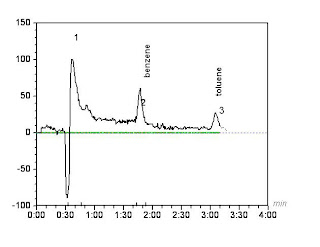A PID Analyzers Model 312 GC (http://www.hnu.com) with a photoionization detector (PID-10.6 eV lamp) is shown below and was used to detect ppt (parts per trillion) levels of benzene in an air nitrogen mix. A 100 ppb standard of benzene in air was diluted with prepurified nitrogen to obtain ppt levels of benzene. A chromatogram with 500 ppt of benzene is show in the Figure below.
The column was a 30M x 0.32 mm id with a 5 micron film of methyl silicon ( http://www.vici.com/). The column flowrate was 6 cc/min of hydrogen with an additional makeup of 6 cc/min. The temperature was isothermal at 120C. The sample was injected with a 10 port valve that had a 0.2 cc loop.
Our PID, with a sealed window, is the most sensitive one available since ppt levels of aromatics can be detected by direct injection without preconcentration. This detector has a very wide dynamic range of 108.
Saturday, April 30, 2011
Saturday, April 16, 2011
GC Detectors: Low ppb Levels of BTEX in water by Headspace GC
GC Detectors: Low ppb Levels of BTEX in water by Headspace GC: "We have used a PID Analyzers GC312 (portable GC) with a photoionization detector (PID) http://www.hnu.com/ for analysis of VOC's in water us..."
Low ppb Levels of BTEX in water by Headspace GC
We have used a PID Analyzers GC312 (portable GC) with a photoionization detector (PID) http://www.hnu.com/ for analysis of VOC's in water using the headspace method (40 ml VOA vials). The sample injected was 0.2 cc of headspace. A 1 ppm mix of 524.2 was prepared as a standard. The BTEX compounds were identified and used as standards for analysis of unknown field samples. A 30M x 0.32 mm id with a 5 micron film of methyl silicon ( http://www.vici.com/ The chromatogram for the standard is shown below:
One of the samples containing 20 ppb of BTEX is shown below:
The sensitivity of the method is displayed in the following sample that was found to contain 3 ppb of benzene:
This method clearly has ppt level capability by simply injecting a larger sample volume eg 1 cc instead of 0.2cc. The headspace GC method is ideal for field measurements since it requires little incremental equipment (40 ml VOA vials, 1 cc gas tight syringe) and is easy to implement.
One of the samples containing 20 ppb of BTEX is shown below:
The sensitivity of the method is displayed in the following sample that was found to contain 3 ppb of benzene:
This method clearly has ppt level capability by simply injecting a larger sample volume eg 1 cc instead of 0.2cc. The headspace GC method is ideal for field measurements since it requires little incremental equipment (40 ml VOA vials, 1 cc gas tight syringe) and is easy to implement.
Labels:
BTEX,
Headspace,
PID,
PID Analyzers,
ppb,
ppt,
VICI,
water samples
Subscribe to:
Posts (Atom)




